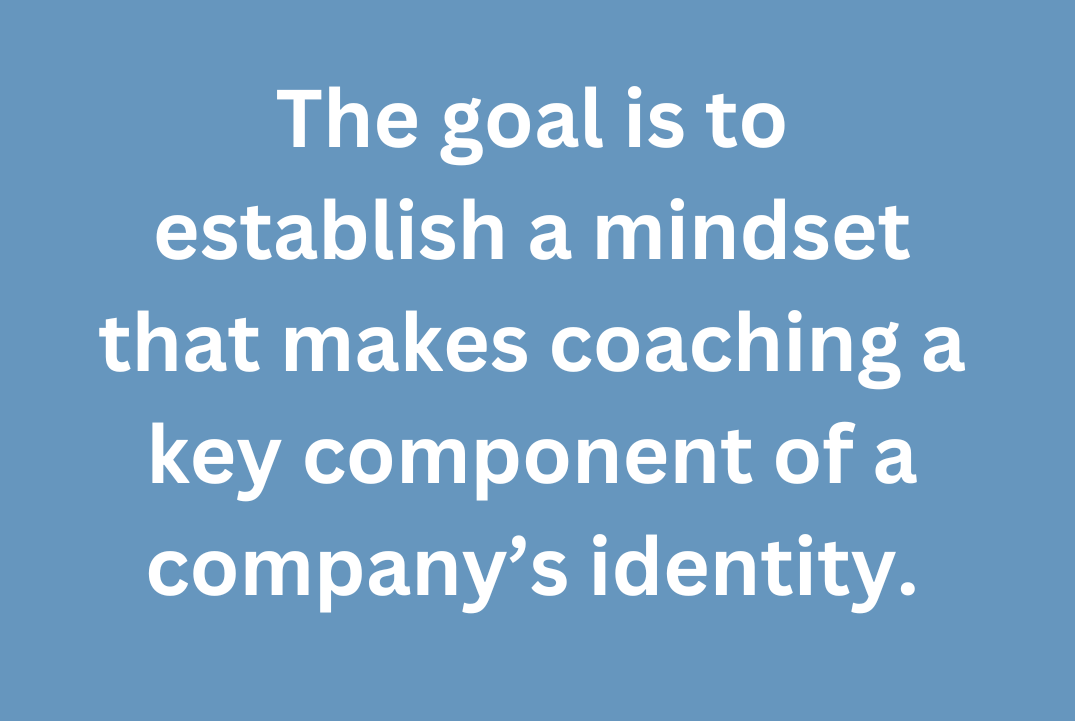Building a culture of coaching means shifting written and unwritten rules, adjusting norms of behaviors, and establishing revised procedures and practices. The goal is to establish a mindset that makes coaching a key component of a company’s identity.
A genuine culture of coaching creates a workplace where people freely:
- Give and receive feedback without fear of ridicule, reprisal, or reprimand,
- Support and expand each other’s thinking,
- Challenge each other with new ideas and processes when appropriate,
- Engage in on-going conversations that are honest, candid, and sincere.
The benefits derived from a culture of coaching can be enormous. With that thought in mind, here are some strategies that can be deployed to create a culture of coaching.
- Lead by Example
Demonstrate leadership in doing the job, i.e., lead by example. When leading by example, leaders change the message of “you may need assistance, but I’m just fine,” to “I’ve benefited, and now I want you to experience this.” Such an approach is at the heart of coaching.
- Start at the Top
Start by teaching senior leaders some coaching basics — listening, asking questions, and encouraging others to think and develop insights before giving advice. Then guide them to coach their most respected team members. As these “influencers” gain traction from being coached, they will be open to learning and modeling the same coaching behaviors. Over time, a coaching culture will emerge.
- Make Managers Accountable for Developing Employees
Create a coaching culture by tying this activity to the company’s mission, and hold managers accountable for coaching employees to help them master their jobs and learn new skills. Create a structured process with clear goals for coaching employees. Be sure to make time and resources available to guarantee success.
- Tell Them to Ask More Questions Than They Answer
When an employee asks a leader what to do, they should respond with questions like: “What do you think will work? What alternatives have you considered? What other ideas do you have?” In a culture of coaching, people value each others’ opinions and input. In such an environment, people feel empowered to make decisions and defend them if necessary. Over time, managers will find that their subordinates bring them solutions instead of problems, and everyone benefits.
- Walk the Talk
To cultivate a culture of coaching you need to build a workplace that “walks the talk,” meaning that people do what they say they will do. For example, if the CEO professes to have an open-door policy, then that door really needs to be open. Authentic communication and honored commitments go a long way towards building this new culture of coaching and accountability.

- Explain to Leaders Why Coaching is Powerful
Contrary to popular belief, coaching isn’t exclusively for developmental purposes, it’s also for meeting everyday challenges. Coaching can often solve routine problems in minutes, as opposed to other forms of management that may force people to do things that feel inappropriate or leave them in limbo for weeks. Therefore, encourage leaders to engage in ongoing coaching conversations with their reports and fellow managers. Tell them the stronger their own coaching skills, the more they can exemplify the benefits of coaching to the entire organization.
- Coach Employees Across the Board
To successfully integrate coaching into a workplace culture, train individuals at all levels of the organization in coaching practices. Too often, companies try to bring in “coaching” that’s not actual coaching, but more like mentoring or advising. In a true culture of coaching, everyone is ready, willing, and able
to help and guide everyone else. Therefore, instruct as deep a pool of employees in coaching methods as possible.
- Build a Coaching Routine
You can’t have a coaching culture without a coaching routine. As an example, one high-performing sales manager created a coaching culture by allocating an entire day each week to coaching. Make coaching a part of a company’s culture by practicing it within a regular and established schedule.
• •
Building a culture of coaching takes time, dedication, and persistence to instill coaching practices as part of the norm at large or diversified companies.
To get things started, leaders must be active advocates of this cultural shift, and use some of the techniques listed above to get there.
Creating a culture of coaching in your organization will take time and is worth the investment. This will make your firm a great place to work. Get other ideas by reading our article on 11 Ways to Make Your Company a “Best Place to Work”
If you would like assistance with creating a culture of coaching within your organization, please contact us to get a group of leaders coached and trained to coach to initiate the process.
Here are more resources related to this topic:
Articles
- Best Practices for Creating an Effective Leadership Training Program at your Company
- Empowering Your Leadership Through Executive Coaching Services
- Building a Culture of Accountability in Your Organization
- Team Coaching: What it is and How it Works, in a Nutshell
Case Study
Guide
YouTube Videos
- A Guide to Team Coaching: What You Need to Know (It’s Not Just Coaching!)
- Five Steps to Greater Accountability in Your Organization
- 11 Ways to Make Your Company a “Best Place to Work” – Part 1
- Part 2 of 11 Ways to Make Your Company a “Best Place to Work”
Photo copyright: Featured photo is from ©August de Richelieu via Pexels. Secondary photo is from ©Christina Morillo via Pexels.




















